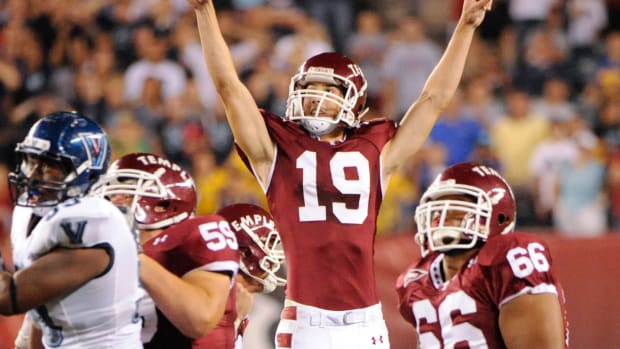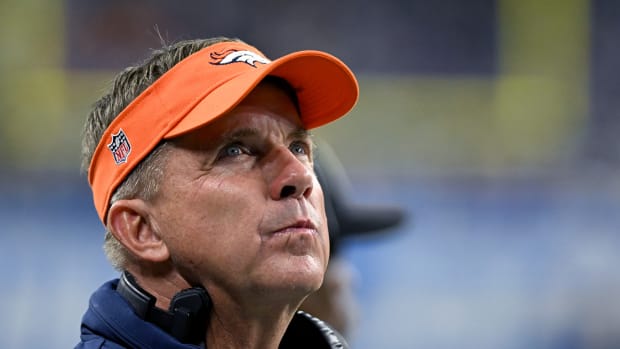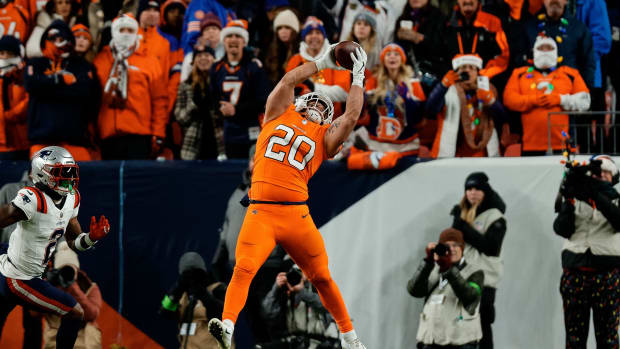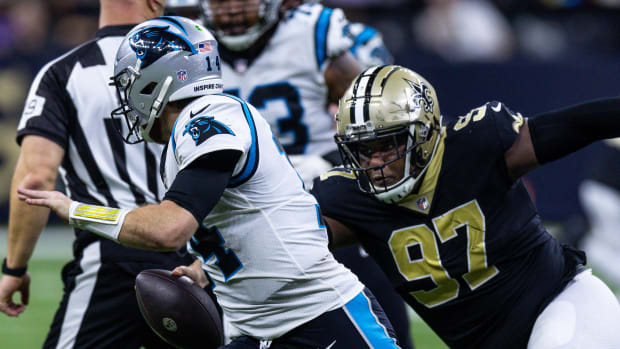5 Offensive Changes Rich Scangarello Made That Paid Dividends in Week 9
Over the first eight weeks of the season, there were definitely issues with the Denver Broncos' play-calling. It wasn’t just the calls, but game-planning and aggression.
These are issues that caused players like Phillip Lindsay, Emmanuel Sanders, and Joe Flacco, as well as head coach Vic Fangio, to call out their offensive coordinator Rich Scangarello.
Denver needed Scangarello to step up and make adjustments, something that was missing the first eight weeks of the season, and he did that. Of course, the quarterback change did help, as Brandon Allen was a lot more mobile, allowing the Broncos to run their bootlegs a bit more effectively.
There is no question that Flacco was part of the problem and not just for the lack of mobility, but for the lack of fire he had. He drained the life out of other offensive players, and it showed.
Breaking down the Broncos' 24-19 victory over the Cleveland Browns, there were many elements in the offense that made me wonder, where were they the first eight games of the season?
The elements I'm talking about can and should be a part of the offense, no matter if you have a quarterback like Russel Wilson, or a pocket statue. These elements can help out an offense no matter the quarterback. So what exactly did Scangarello change up in Week 9 with a new QB under center?
The fact that they weren’t present in the offense before speaks to the failures of Scangarello during the first eight games, though there are other ways he struggled as well. Adding these elements really helped the Broncos offense, and I would say it helped them even more than the mobility of the quarterback. Here's what changed on Sunday.
1. Max Protection
This is the one I question the most. When you have a struggling offensive line and an immobile quarterback, you help them out by giving them more protection. That was hardly seen for the first eight weeks of the season.
Max protection keeps eight, maybe nine blockers, back, leaving two receivers running routes with the running back often chipping before slipping out for a dump-off look. Flacco can’t move and the offensive line gave up pressures.
This would have given the Broncos more blockers to give the statue more time without relinquishing pressure if they were able to execute. Yes, this gives the defense the advantage in coverage, which is why when a team calls max protect, they either want to take a shot deep or just end up dumping it off.
Denver ran this with Diontae Spencer as one of the receivers vs. the Browns, and they took the shot to him. Flacco does have more arm talent than Allen, so this should have been part of the offense.
It was weird to see Denver run this with a more mobile quarterback with a weaker arm and never with their immobile signal-caller with the stronger arm.
2. Pick Plays
Running pick plays can be tricky because if not executed perfectly by the receivers, teams can get called for offensive pass interference. We did see this a couple of times in Week 8 against the Indianapolis Colts, but only in a few instances, and one was called for offensive pass interference on TE Noah Fant.
So this is an element we started to see in Week 8, but rarely before that. The picks Denver ran vs. the Browns were a lot simpler than what they tried against the Colts and it got receivers open quickly and helped the offense move the ball. Flacco wasn’t an aggressive quarterback, so adding more pick elements to the passing game would have helped him and the Broncos offense move the ball.
The Broncos really utilized picks on third down, which makes total sense. I mean, get a playmaker open, in space, with room to run and let him make a play.
3. Attacking Defensive Weaknesses
This was my biggest irk with the play-calling of the first eight weeks. Smart offensive coordinators find the weaknesses of the defense and exploit them. Scangarello would do that, but then would go away from it and start attacking their strengths with little to no success.
The Browns defense is a bad unit, but they really struggle with their run defense on their left side (offensive right side) and the Broncos attacked that area in the running game over and over. One of the times it led to a huge 30-yard touchdown run by Lindsay.
Scangarello found the weakness, a vulnerability that was identified prior to the game, and he exploited it. What stands out the most is, he kept hammering at it.
Scangarello didn’t go away from it. It wasn’t like the Colts game, where he found the weakness of Rock Ya-Sin on Courtland Sutton and then stopped attacking there.
4. Being Aggressive
This can be coupled with max protection a little bit at least when it comes to taking shots downfield. It was a little harder to be aggressive for the first eight weeks because of the QB immobility and the issues at tackle. However, there were still ways the Broncos could be aggressive in previous games that we didn’t see but finally showed up against the Browns.
The biggest element was the Broncos stopped playing not to lose and played to win. Denver's play-calls kept them attacking and pushing to gain yards, which wasn’t always effective, but they were fighting. Being complacent can drain the players as much as an emotionally dead quarterback.
When Scangarello and the Broncos decided to be complacent with 2:15 left in the second quarter and three timeouts against the Colts, a lot of offensive players lost their fight. There was no fight from the coaches, so why should they?
Denver came out and ran it twice, getting a clock stoppage with a two-minute warning and then finally passed with 1:25 left. Scangarello and Vic Fangio were content to just run out the clock. The Colts took advantage and used their timeouts and got a field goal before the half.
That was a harbinger that the Broncos were going to lose that game in a similar fashion they lost other games. No one can say how things would have turned out had they been more aggressive, but in those situations and on the road, you have to keep your foot on the gas.
5. Simplified Drops/Routes for Quicker Shots
It was great to see three-step drops from Brandon Allen, or one-step in shotgun and getting the ball out quickly. Having that paired with routes to get receivers open quickly really helped the Broncos move the ball.
This is something we did see quite a bit of from the Broncos with Flacco at quarterback. When Denver did it, they were very effective and they moved the ball.
However, since their Week 4 loss to the Jacksonville Jaguars, the Broncos started to go away from it. Gone were the quick passes and in their place were the long drops with longer-developing routes.
There were multiple instances of a 3rd-&-short where the call was a seven-step drop attacking the intermediate/deep zones with their routes —plays that take a while to develop where the offensive line couldn’t hold up. Yes, Flacco would hold the ball and take a sack while missing an open receiver, but those plays never should have been called in the first place.
You don’t attack like that on 3rd-&-short. That shortcoming, coupled with designed dump-offs to the running backs on 3rd-&-medium to 3rd-&-long, left the play-calling on the money down wanting.
Denver’s use of quick passes has really helped this offense multiple times this season, but they never really stuck to it. The Browns game was the first contest where they used it consistently throughout. Allen averaged 2.41 seconds to throw, which would be tied for second-fastest on the season.
Flacco was an issue for the offense and his inability and immobility really hurt them. However, the offensive coordinator failed to use basic elements to provide help to cover the weaknesses of the offense.
The Takeaway
What is highlighted are just some of the reasons, not including prohibiting Flacco from audibling at the line, as to why Scangarello was doing a bad job as an offensive coordinator. Allen was awarded that freedom and the results speak for themselves.
Yes, Scangarello is a first-year play-caller in the NFL, but these are concepts and elements that are so basic, his inexperience can’t be used as an excuse for why they weren’t used.
It was never one or the other situation with the Broncos offense — the QB or the play-calling. It never is. More than one thing can be true at the same time.
When the Broncos' run defense was struggling so bad, it wasn’t just Shelby Harris failing at nose tackle, but the linebackers failing their gap assignments. What was the fix? The Broncos moved Harris to defensive end and inserted Mike Purcell at nose tackle, as well as inserting Alexander Johnson at inside linebacker, getting Todd Davis some help and resulting in the benching of Josey Jewell and Corey Nelson.
The problem wasn’t just Flacco, but also Scangarello’s inability to properly call plays or use elements to help the offense. What was the fix for the offense?
It wasn’t just a new quarterback, but the adjustments in the play-calling and offense that were applauded by players and coaches after their win against the Browns.
Follow Erick on Twitter @ErickTrickel and @MileHighHuddle.





